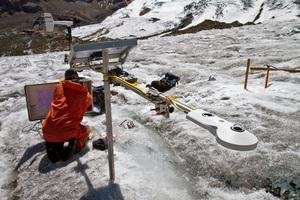Downscaling of Climate Variability: Towards an Impact Assessment for Glaciers in the Cordillera Blanca, Peru

Most glaciers around the world - including those in the tropics - have been retreating over most of the 20th century. Generally, their shrinkage is attributed to global warming. While the global climate conditions certainly play an important role in shaping the environment in which glaciers exist, the mass and energy balance of each individual glacier is dictated by local conditions. Given the generally complex mountain topography around glaciers, natural climate variability, and regional differences in the climate system's evolution, it is not trivial to find a direct link between global climate change and the behavior of an individual glacier.
In the Cordillera Blanca, Peru, glaciers act as important regulators and providers of water supply to the densely populated Rio Santa valley.
Within the framework of the proposed project, steps will be taken towards a better understanding of the processes linking the large scales of climate variability and change to impacts on single glaciers of the Cordillera Blanca.
An existing network of automatic weather stations and glaciological observations will be maintained and extended in order to create a complete observational data basis for the project. Using a limited area model, very high resolution simulations of the atmospheric conditions around the study sites will be performed for selected time slices, using reanalysis data as lateral boundary conditions. The skill of the model will be quantified, and the model dynamics will be analysed in order to identify the most important processes that govern the translation of the large to the local scale in the mountainous terrain.
arameterizations of these processes will be developed and verified through the observational data. Finally, a distributed, energy balance-based glacier mass balance model will first be optimized with the help of the field measurements. The mass balance model will then be run over the entire period of reanalysis data availability, using the parameterizations to create time series of the forcing variables. The produced long-term mass balance series will provide a detailed picture of high-altitude climate change in this region.
The meteorological and glaciological observations obtained through this project will be immensely valuable also for research outside the scope of this project, since the tropical mid-troposphere, where the study site is located, is characterized through extremely scarce data. The dynamical downscaling of the reanalysis data with a numerical model, verified through on-site observations, will increase the insight into the abilities and limitations of high resolution modeling over glacierized and rough terrain. The development of parameterizations for the variables required to force a glacier mass balance model is to be seen as a first step towards the inclusion of tropical mountain glaciers into general circulation models, and thereby a necessary prerequisite for studying impacts of climate change on glaciers, water resources, and local communities in Peru.
Project Leader:
Ben MARZEION
Members:
Marlis HOFER
Co-PI:
Georg KASER
Funding Agencies:
FWF
Project Duration:
01/01/2009 to 31/12/2014
